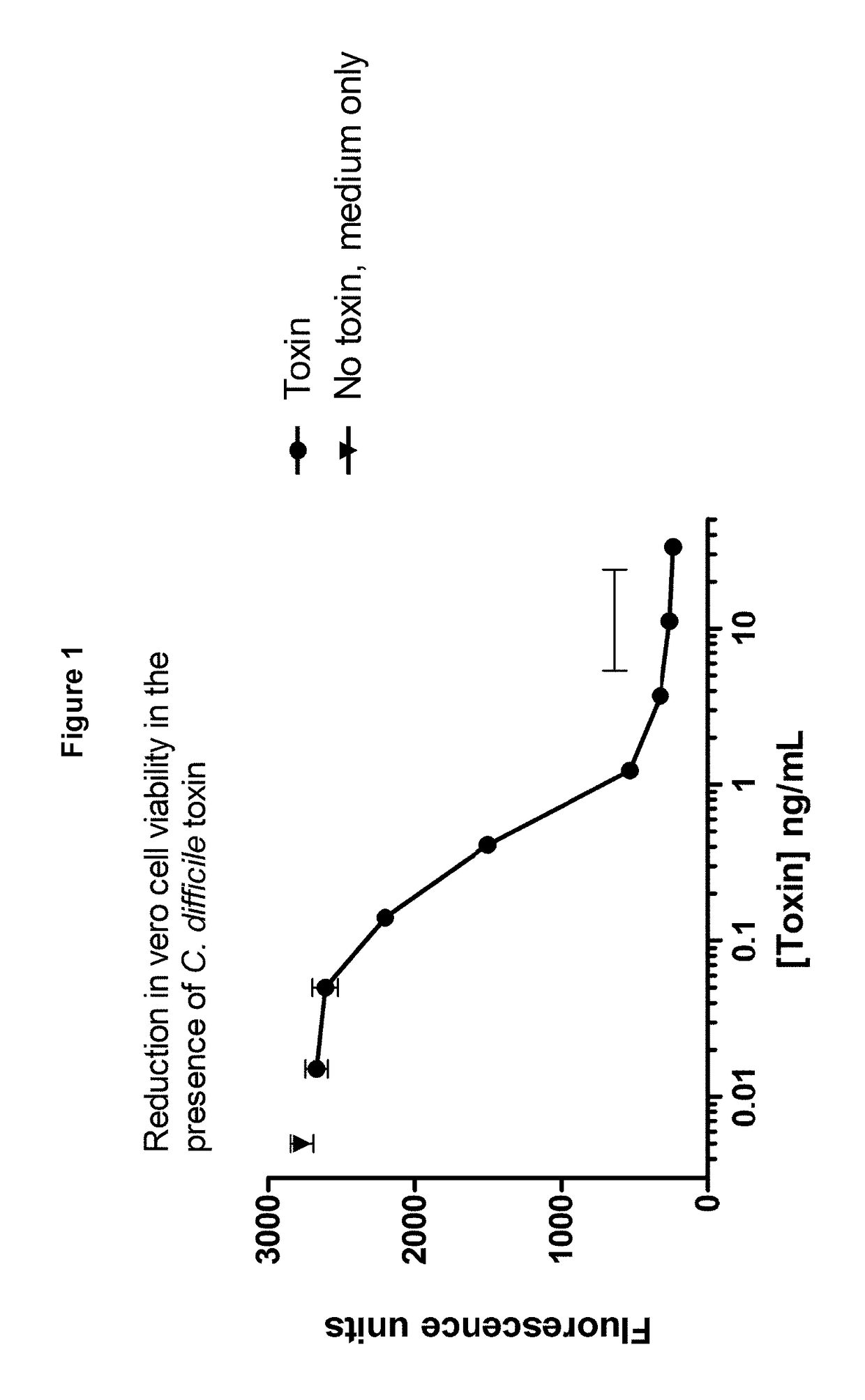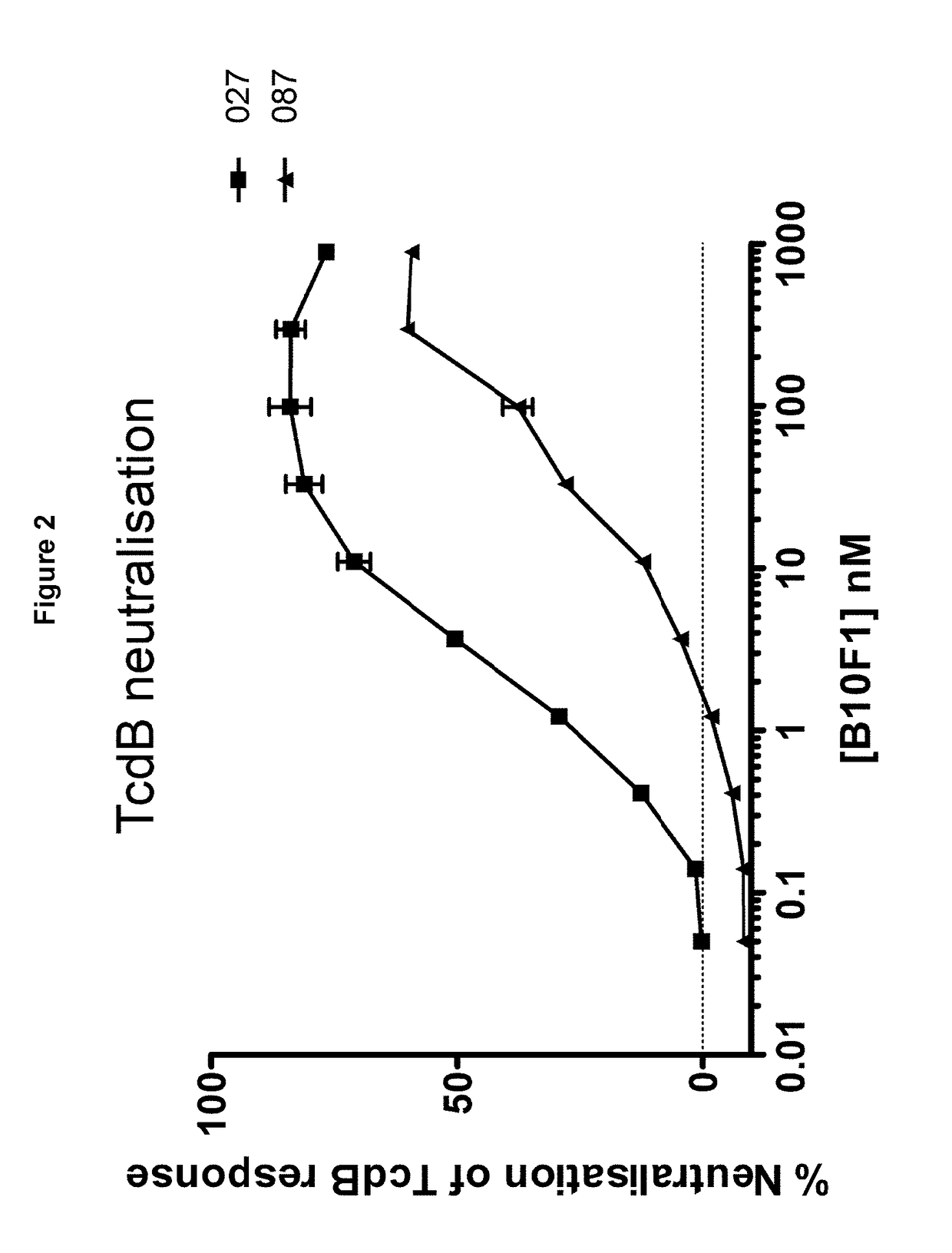Polypeptide comprising an immunoglobulin chain variable domain which binds to clostridium difficile toxin b
- Summary
- Abstract
- Description
- Claims
- Application Information
AI Technical Summary
Benefits of technology
Problems solved by technology
Method used
Image
Examples
example 1
Llama Immunisation
[0277]Llama immunisations were carried out using two different immunisation protocols to optimise the chance of obtaining potent cross-strain neutralising antibodies against TcdB.
[0278]Under the first protocol, two llamas were primed with 100 ug of TcdB toxoids prepared by formalin inactivation of purified TcdB from a C. difficile 027 strain, as well as with 107 formalin inactivated spores from C. difficile strain 017 (M68) using Specol adjuvant. Llama 2 was boosted at 7, 14, 21, 28, 35 days with the same antigens, except that from day 14, gamma irradiated spores rather than formalin inactivated spores were used. In addition, the adjuvant was changed to IMS1312 for the last two boosts. Llama 1 had a similar immunisation protocol except that two further boosts were given on days 42 and 49. For llama 1, formalin inactivated spores were used on days 0, 7, 14 and 21, and Specol was the adjuvant. However, thereafter the adjuvant was changed to IMS1312 and gamma irradiat...
example 2
Phage Display, ICVD Selection and Production
[0280]RNA extracted from the llama lymphocytes was transcribed into cDNA using a reverse transcriptase kit. The cDNA was cleaned on PCR cleaning columns. IgH (both conventional and heavy chain) fragments were amplified using primers annealing at the leader sequence region and at the CH2 region. Two DNA fragments (˜700 bp and 900 bp) were amplified representing VHHs and VHs, respectively. The 700 bp fragment was cut from the gel and purified. A sample was used as a template for nested PCR. The amplified fragment was cleaned on a column and eluted. The eluted DNA was digested with BstEll and Sfil, and the 400 bp fragment was isolated from the gel. The fragments were ligated into the phagemid pUR8100 and transformed into E. coli TG1. Bacteria from overnight grown cultures of the libraries were collected and stored. The optical density at 600 nm (OD600) of these stocks was measured. The insert frequency was determined by picking multiple diffe...
example 3
Modification of ICVDs
[0285]A series of modified anti-TcdB ICVDs were produced by yeast expression of DNA constructs (see Preparative Methods section, above). Heterobiheads were linked using a [Gly4Ser]4 amino acid linker. The modified anti-TcdB ICVDs were the following:[0286]ID1B (B10F1 with Q1D and R27A)[0287]ID2B (Q31 B1 with El D, V5Q and R27A)[0288]ID11B (Q31B1×B10F1 hetero bihead with [G4S]4 linker)[0289]ID12B (Q35H8×B10F1 hetero bihead with [G4S]4 linker)
[0290]The sequences of these modified ICVDs are provided in Table 1A.
PUM
| Property | Measurement | Unit |
|---|---|---|
| Molar density | aaaaa | aaaaa |
| Molar density | aaaaa | aaaaa |
| Molar density | aaaaa | aaaaa |
Abstract
Description
Claims
Application Information
 Login to View More
Login to View More - R&D
- Intellectual Property
- Life Sciences
- Materials
- Tech Scout
- Unparalleled Data Quality
- Higher Quality Content
- 60% Fewer Hallucinations
Browse by: Latest US Patents, China's latest patents, Technical Efficacy Thesaurus, Application Domain, Technology Topic, Popular Technical Reports.
© 2025 PatSnap. All rights reserved.Legal|Privacy policy|Modern Slavery Act Transparency Statement|Sitemap|About US| Contact US: help@patsnap.com



